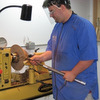Since my start into woodturning I've been using a Thompson 12V, 1/2" bowl gouge that is ground with a 60 degree included angle. I've heard so much about the 40/40 grind that I wanted to give it a try. Luckily I have a 5/8" bowl gouge that is ground close to the 40 degree angle on the tip but not the wings. I reground it to a shape I believe is correct. What can I expect while using it? Are there any changes as far as technique that should be applied?




 Reply With Quote
Reply With Quote




